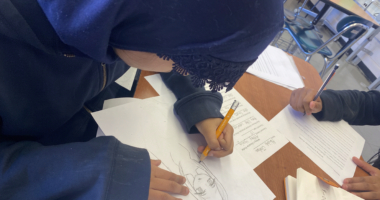As I continue to work with PS 676’s 2nd and 3rd grade classes, I’ve been building relationships with the students in the classroom. The process began by starting to match names to faces, and slowly working towards gaining the students’ trust so that they ask me questions and accept my compliments on their success. It’s very exciting to work with the students at this particular moment, as we build towards a final culminating event and the Teaching Artists and I discuss Community-Word Project’s signature Mural Project.
As I mentioned in a previous entry, PS 676’s curriculum at The Neighborhood School in Red Hook has been focused on writing an Urban Fairytale, through the creation of poems and visual stories based on the collaborative title Brooklyn Bridge is Dancing to Hip Hop. The students have begun to create storybooks with their poems on colorful construction paper. The front book end begins with an illustration that folds open into the poem they drafted on the white paper. The illustration lesson began with an introduction to the word “Visualization.” This was a mouthful for the students to wrap their heads around, but we began by asking them their thoughts, and then broke down the words within the word to gather the full meaning. The visualization was the process of transferring their text based poem into visual metaphor, building upon a second vocabulary word learned in earlier lessons.
I really enjoyed seeing a main activity develop over many phases. This process allows the students to revisit and continue to locate the beauty and value in their work. It is also a truly artistic practice. To return, and revise, and build upon something we started before. Since creating a mock lesson in the Teaching Artist Training & Internship Program (TATIP), and exploring my mock lesson in trial form with adults, I felt a lot of anxiety about taking so much time to plan and work toward ideas that would only be explored in one day. But I see now that it truly takes time to unwind artistic concepts and vocabulary, and for the students to generate their own work. And I can see how new lessons overlap, seamlessly.
In my continued visits, I learned more about the logistical elements to working as a Teaching Artist. Most notably that the time of day assigned to a residency can greatly affect the timespan you have with a class. Although we have 50 minutes allotted, since my session directly follows lunch, I learned the students were not just late on my first class. Instead, their scheduled hour when lunch ends, does not account for travel time to their new classroom upstairs at the opposite side of the building, which is about a 10-15 minute transition for a group of 2nd and 3rd graders. There is a basic logistical concern that consistently shortens the time we have with the students and affects the length we have in the main activity. However, the process of making it work has been truly magical. Although we may not have as much time to share one on one, students hold up their work to view at the end, and there is all the more excitement leading to the next lesson when the outline of the mural will begin to form.
One of my favorite rituals regarding the work is having a moment to check in with my mentors after class. We use this moment to discuss anything I’ve noticed or wish to reflect on and ask questions about. This process is important in general for the Teaching Artists to learn more about what another set of eyes noticed in the classroom, as well as the opportunity for the trainees to expand our toolsets and gain insight into their planning, methods and perspective. I’ve noticed this during the time the Teaching Artists take to speak with us as they take their break, eat their lunch and begin to prep for reflections with the classroom teachers. Using their break time to discuss the work is highly generous.
I’ve learned that the residency process is extensively collaborative on all sides. The Teaching Artists work to integrate the methods and subjects the classroom teachers explore in their coursework, and the classroom teachers continually chime in to support the additional breakdown of concepts they may notice some students struggling to grasp. The classroom teachers and the Teaching Artists collaborate to make sure that they are integrating both curriculums in the lesson planning.
There is another moment post lesson that is another crucial review. It may be related to our time being cut short, but just after the students transition to Math, we, as Teaching Artists take a moment to take in the work the students created during the day, to celebrate all of our accomplishments. We use this moment to identify the strengths and areas we want to continue to encourage the students to grow. There are truly some amazing gems and I am learning that the Teaching Artists make executive decisions regarding what work will become central to the collective project and mural by selecting the strongest examples, based on their reflection of the lesson’s goals and skills present in the art.
-Katrina De Wees, Dancer, TATIP Trainee



